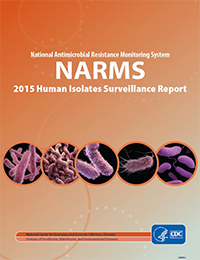
New Report on Antibiotic-resistant Infections

The NARMS 2015 Human Isolates Surveillance Report provides the most recent nationwide data on antibiotic resistance among six types of bacteria that can cause diarrhea or bloodstream infections. These bacteria are commonly spread through food. For this report, NARMS conducted whole genome sequencing (WGS) of all nontyphoidal Salmonella collected in 2015. Genetic data provided by this sequencing can be used to identify resistance genes and predict antimicrobial resistance.
Key findings:
- WGS data provides more information on the types of genes that make bacteria resistant to clinically important drugs. For example, among 65 ceftriaxone-resistant Salmonellaisolates from sick people tested in 2015, 8 had a type of resistance gene that is rare in the United States and is often linked to international travel.
- Among nontyphoidal Salmonella, 5.8 percent of the isolates tested were not susceptible to ciprofloxacin, meaning the antibiotic may not kill the bacteria and it may multiply. This was the highest percentage since testing began in 1996. Among Enteritidis (the most common Salmonella serotype), 14% were not susceptible, up from 8% in 2014. Ciprofloxacin, an important treatment option for severe Salmonella infections in adults.
- Decreased susceptibility to azithromycin (DSA) among Shigella increased to 9.8% in 2015. DSA among Shigella sonnei was 6.1% in 2015 and among species flexneri, DSA increased to 33%, up from 22% in 2014. Azithromycin is one of the preferred antimicrobial agents for adults and children with Shigella infections.
For more information:
- Read about overall trends of antibiotic resistance among foodborne pathogens in the 2015 NARMS Annual Human Isolates Report.
- Check out NARMS Now, an interactive web tool for viewing data.
- Learn more about what CDC is doing to combat antibiotic resistance and keep food safe.






















.png)











No hay comentarios:
Publicar un comentario